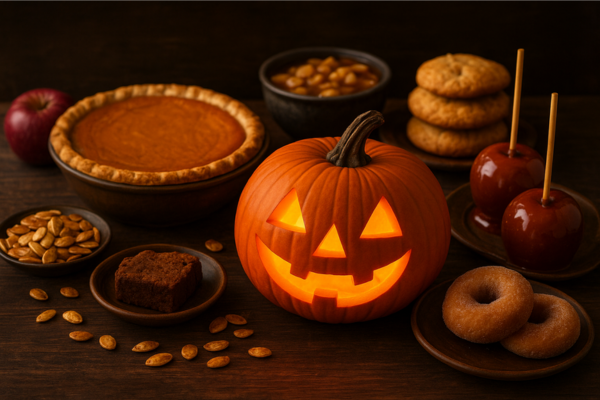Traditional Food of Halloween
Halloween, celebrated on October 31st, is more than just costumes, spooky decorations, and trick-or-treating. It’s a festival deeply rooted in ancient traditions that date back thousands of years, and one of its most fascinating aspects is the food associated with it. Traditional Halloween foods reflect the spirit of the season—harvest, warmth, and the mysterious connection between the living and the spirit world. From soul cakes to caramel apples, each dish carries a story that connects modern celebrations to the ancient Celtic festival of Samhain.
The Ancient Origins of Halloween Food
Halloween’s earliest roots lie in the Celtic festival of Samhain, celebrated over 2,000 years ago in Ireland, Scotland, and parts of Northern Europe. During Samhain, people believed the veil between the living and the dead was thinnest, allowing spirits to cross into the human world. To honor these spirits and protect themselves from harm, families would leave out offerings of food and drink. These offerings were believed to appease wandering souls and ensure good fortune for the coming winter.
Many traditional Halloween foods today still carry the essence of this harvest season. They often feature autumn ingredients such as pumpkins, apples, potatoes, grains, and nuts—foods that were readily available after the fall harvest.
Pumpkin Dishes: A Modern Symbol of Halloween
While pumpkins are now the iconic image of Halloween, their use began as a practical and symbolic choice. Early Irish immigrants to America discovered pumpkins were easier to carve than turnips, leading to the creation of the famous jack-o’-lantern. Over time, pumpkins also made their way into Halloween cuisine.
Traditional dishes include pumpkin pie, pumpkin bread, roasted pumpkin seeds, and pumpkin soup. These foods not only represent the harvest but also embody warmth and comfort during the chilly autumn nights. The sweet, earthy flavor of pumpkin reminds people of family gatherings, festive decorations, and the changing of the seasons.
Apples: The Fruit of Fortune and Festivity
Apples have been associated with Halloween for centuries, symbolizing abundance, health, and even romance. In Celtic mythology, apples were considered magical fruits linked to immortality and the otherworld. The popular game of bobbing for apples comes from an old love divination ritual where young people tried to bite into floating apples to reveal their romantic fate.
One of the most beloved traditional Halloween treats is the toffee apple or caramel apple. Covered in a shiny, sugary coating, this festive snack captures the essence of autumn. Other apple-based treats such as apple cider, apple pie, and spiced apple donuts also play a major role in Halloween feasts, filling homes with the comforting scent of cinnamon and cloves.
Soul Cakes and the Origins of Trick-or-Treating
Long before modern trick-or-treating began, people practiced a custom known as souling. During medieval times, the poor and children would go door to door offering prayers for the dead in exchange for small round cakes called soul cakes. These spiced cakes, often marked with a cross, were baked in remembrance of departed souls.
This act of sharing soul cakes was meant to bless both the giver and the receiver. Over time, the tradition evolved, blending with other cultural customs, and eventually became the trick-or-treating we know today.
Other Traditional Halloween Foods Around the World
Different cultures have their own special dishes to celebrate Halloween or similar festivals honoring the dead. In Ireland, colcannon—a mix of mashed potatoes, kale, and butter—is a common dish, sometimes with hidden charms predicting future luck. In Mexico, pan de muerto, a sweet bread decorated with bone-like designs, is enjoyed during the Day of the Dead celebrations. In Scotland, a fruitcake called barmbrack is baked with symbolic items hidden inside, each representing a fortune for the coming year.
Traditional Halloween foods are more than seasonal treats—they are living memories of ancient customs and beliefs. Whether it’s a steaming bowl of colcannon, a slice of pumpkin pie, or a bite into a caramel apple, each dish carries a sense of history and connection to the spirit of the harvest. These foods remind us that Halloween is not only about scares and sweets but also about celebrating life, community, and the cycles of nature. Through food, the magic and mystery of Halloween continue to live on, generation after generation.
